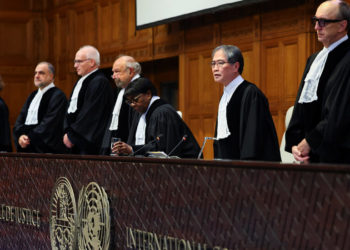In tiny Denton, N.C., population about 1,600, some Confederate monuments removed from coastal Wilmington, more than three hours drive away, appear to have found a new home at the private Valor Memorial Park.
One was originally erected in 1911, nearly half a century after the end of the Civil War, to honor a local railroad attorney who became the last Confederate attorney general — “Scholar, Patriot, Statesman, Christian,” as the descriptors carved into the memorial’s granite base declares. The other, dedicated more generally to Confederate soldiers from the area, went up in 1924.
The United Daughters of the Confederacy sponsored both. They set out to create twisted public sculptures in enduring bronze that would fabricate a “noble” legacy to reinforce the modern white supremacy of Jim Crow’s racial segregation. Valor Memorial Park stands as a kind of petting zoo for tributes to the moral sewage of Lost Cause mythology. It’s emblematic of why a timely new museum exhibition in Los Angeles is so vitally important.
“MONUMENTS,” the all-caps in the title sounding a loud alarm, is the most significant show in an American art museum right now. Ghastly homages to white supremacy, often suffused with the anti-democratic demands of Christian nationalism, have been on the treacherous rise for a decade. The exhibition pairs cautionary art history with thoughtful and poetic retorts from 20 artists, including a nonprofit art studio.
It’s thrilling. Jointly organized by the Museum of Contemporary Art and a small nonprofit called the Brick, it has been in the works for nearly eight years. The decision to bring decommissioned Confederate memorial sculptures inside the museum for sober analysis at first raised eyebrows, as much in excitement as in surprise. Nothing like it had ever been done before, but ominous recent events made it imperative.
In 2015 a white supremacist mass murderer had slaughtered nine Black parishioners and wounded a 10th during a prayer meeting at fabled Mother Emanuel A.M.E. Church in Charleston, S.C. A year later, a white political candidate whose campaign showcased a reactionary lie that his Black predecessor was not born in the United States assumed the presidency, losing the popular vote but winning the Electoral College — itself an institution born of white supremacy. Two years later, a white supremacist mob carrying Confederate and Nazi flags in support of the so-called “great replacement theory,” a racist fantasy about a plot to diminish the influence of white people, marched in Charlottesville, Va., inciting a riot and killing one. Swastikas and Confederate flags would later swarm Congress during the Jan. 6 domestic terror attack.
When George Floyd was murdered by police in 2020, many statues were defaced or toppled. Calls for the removal of hundreds of Confederate monuments across the country swelled. The nascent exhibition idea blossomed, and a show was assembled by Hamza Walker with Hannah Burstein at the Brick, MOCA’s Bennett Simpson with Paula Kroll, and artist Kara Walker.
MOCA’s Geffen Contemporary warehouse space in Little Tokyo is an ideal venue, not least because it’s next door to the Japanese American National Museum’s Democracy Center — the site where thousands of U.S. citizens of Asian ancestry were rounded up in 1942 to be sent to concentration camps. Modern white supremacy burns through the exhibition, both as searing illumination of its vile contours and as clenched fury at its intractable endurance.
The show has two focal points. One is 10 actual examples of these memorials, several monumental in size and many splashed with protesters’ paint. The other is recent art, some commissioned in direct response and some preexisting, including period portrait photographs by Hugh Mangum. The two are beautifully integrated in the galleries.
The monuments are astonishing to see, if only because one typically encounters them as an outdoor drive-by, raised high on tall pedestals that lift them 10, 30, even 50 feet in the air. Here, we stand on the same plane, face to face. Elevated stature is erased.
Cauleen Smith emphasizes this lofted art’s surveillance function, where a statue of Confederate President Jefferson Davis or Civil War turncoat Robert E. Lee is in place partly to let citizens — Black, white or otherwise — know that whiteness still rules the roost. Smith has trained a live camera on a raised arm, finger pointed up, from a 1907 allegorical figure by Edward V. Valentine called “Vindicatrix,” also known as “Miss Confederacy.” Her finger is broadcast, aiming heavenward, on flat screens scattered around the show, like a motion detector that turns on lights in a dark alley to silently alert passersby of their endangered status.
The heavenly finger’s subtle specter of warped Christianity gets emphatic in a 1917 pietà designed by J. Maxwell Miller to celebrate Confederate women in Maryland. A soldier wrapped in a battle flag is cradled by a woman, like the dead Jesus draped across Mary’s lap, a second woman rising behind them like a secular St. Anne. The composition is repulsive. White supremacy debases Jesus’ actual teachings of radical equality, just as it makes democracy impossible. Lost Cause mythology relies on perversions of holiness to spread its hateful propaganda.
The poignancy of this cruel spiritual appropriation is pictured by Jon Henry in 14 photographs of Black mothers cradling sons, their pietà poses sprawled at actual locations of police killings of Black men. And it assumes an ecstatic, operatic scale in a breathtaking 10-minute projection by filmmaker Julie Dash featuring operatic bass-baritone Davóne Tines, which traverses the interior of Mother Emanuel church in song to arrive at an ancient, spectacularly beautiful tree, known as the Angel Oak, just outside Charleston. The roughly 400-year-old specimen of spreading and enveloping branches was just a sapling at chattel slavery’s 1619 arrival in North America.
At the show’s entry, the remarkable remains of the Robert E. Lee statue whose planned removal from a public park ignited the deadly Unite the Right rally are spread across a low pedestal. The 1924 bronze sculpture by Henry Shrady and Leo Lentelli was deeded to Charlottesville’s Jefferson School African American Heritage Center, a Black-led nonprofit, whose members had it cut up, the pieces melted down and then recast in the image of stacked gold bricks, awaiting repurposing. The allusion to economic justifications for the Confederacy’s inhumane cruelty is mocked and transformed, while also implying the process as Black reparation. A slice of the granite base with Lee’s name and dates is graffitied with the legend, “as white supremacy crumbles.” The transformation of an instrument of war into a tool for peace is made manifest — art swords into aesthetic plowshares.
The Lee statue’s partner, an imposing 1921 Charlottesville equestrian sculpture of Thomas “Stonewall” Jackson and his famous horse, Little Sorrel, by Charles Keck, was the raw material for Kara Walker’s devastating piece at the Brick. Bluntly titled “Unmanned Drone,” and shown with a selection of preparatory drawings, collages and documentary material that illuminate her process and three works made from the stone base, the sculpture likewise cut up the original, but then reassembled the pieces into a monstrous mutant. Keck’s horizontal equestrian sculpture, which intimates occupation of the land, became Walker’s vertical, a grotesque standing humanoid, disemboweled.
The fiend has no head. The folkloric Euro-American story of the “headless horseman” comes to mind — a nightmarish, animated corpse who haunts the living. As a metaphor for obtuse white supremacy, still active today, that terror figure is hard to beat.
But Walker’s brilliant sculpture goes further. Her fractured, broken, faceted statue is Cubist in structure. Multiple sides of Jackson (and Sorrel) are seen at once, enabled by a revolutionary modern style. Cubism was not only dominant in 1921, when Keck made his stylistically retrograde statue, but its genesis owes much to African art. Walker’s gesture is clarifying.
One thing it clarifies is why Jim Crow monuments are all rendered in the same backward, Beaux-Arts style, exploiting classical forms and elaborate ornamentation harnessed for the 1890s City Beautiful movement. It isn’t only because dramatic realism is broadly appealing to a public in ways modern abstraction isn’t. Instead, using Beaux-Arts style deep into the 20th century invoked the pre-modern past. Several of these artists were students of the great 19th century Beaux-Arts sculptor Augustus Saint-Gaudens, who was a generation older.
Jim Crow sculptures summoned visual tradition as a prestige podium from which to rerun racist hate. Just last August the same repressive strategy drove a ludicrous presidential executive order demanding only “classical architecture” for America’s new civic buildings. Think of it as MAGA style.
At MOCA, some of those elaborate white supremacist monuments are skillfully crafted. Laura Gardin Fraser, the only woman among the monument sculptors here, designed a powerful double-equestrian sculpture of Lee and Jackson for Baltimore, unveiled in 1948. (“Beware traitors” is now slathered across the base.) The show juxtaposes the prancing duo with Hank Willis Thomas’ 2019 “A Suspension of Hostilities,” which rams into the ground an upended muscle car — dubbed the Gen. Lee — a replica from the 1980s “Dukes of Hazzard” TV show, decorated on the roof with a Confederate battle flag. The Cold War reveled in any and all assertions of American power, and by the time the conservative Reagan era came along, a backlash to civil rights advances saw some white supremacist imagery mindlessly absorbed into a pop culture amusement.
The exhibition’s most elaborate sculpture features oceanographer Matthew Fontaine Maury, a die-hard racist and prominent cartographer of ocean and wind currents who revolutionized sea-faring navigation standards. It is, in some ways, the most pernicious because it strays far afield from direct claims of military and political heroism to celebrate a scientist, a profession built around facts. Prolific sculptor Frederick William Sievers shows a seated Maury enthroned like Zeus before a globe held aloft by swarming figures representing the forces of air and water.
Maury exploited his scientific acumen to contend for the truth of insane white supremacy beliefs, often with distorted biblical window dressing. Hanging high on walls surrounding the 1929 sculpture, later marred by graffiti, are six recent abstract paintings by Walter Price. Horizontal lines of layered color formed by the artist’s marching footprints, tracked across the canvases, create unruly waves, their shapes sometimes suggesting schools of fish. Visually, Price dropped the room’s grandiose oceanographer monument to the bottom of the sea.
The removal of more than 200 Confederate monuments in the last half-dozen years is a hopeful sign, but one tempered by knowledge that more than three times as many still stand. And then there’s that absurd Valor Memorial Park, not to mention the white supremacist and Christian nationalist politicians now blighting Washington, D.C. The exhibition’s one disappointment is that its catalog won’t be published until February, so that installation photographs can be added. Surely a digital version could have been made immediately available. We need it now.
As an estimated 7 million Americans in big cities and small rural towns demonstrated Saturday, marching in the largest street protest in U.S. history, the call is urgent. “Monuments” has met the moment.
The post The most significant American art museum show right now topples white supremacy appeared first on Los Angeles Times.




